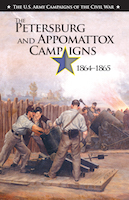Campaigns of the Civil War

THE PETERSBURG AND APPOMATTOX CAMPAIGNS, 1864–1865
John R. Maass
U.S. Army Campaigns of the Civil War
CMH Pub 75-16, Paper
2015; 72 pages, maps, illustrations, further readings
GPO S/N: 008-029-00586-7
In the Civil War's last year, two great adversaries squared off in central Virginia in a series of battles that eventually determined the struggle's outcome. After a month of battles from the Wilderness to Cold Harbor in May and June, 1864, Union Commander in Chief Lt. Gen. Ulysses S. Grant was frustrated in his headstrong attempts to batter the Confederate forces under General Robert E. Lee and bring them to open battle. Seeking to sidestep Lee's army and attack Richmond, the Confederacy's capital city, Grant moved south to cross the James River and cut the rebel army's supply lines at Petersburg, Virginia, where several key railroads met to form a crucial logistical center. Lee, however, reacted in time to block the Union strike at Petersburg. A ten month siege ensued as Grant sought to pry Lee out of Petersburg with flanking maneuvers, and the Confederates desperately defended the city and Richmond.
Lee's lines finally collapsed on 2 April 1865 after a powerful Federal attack on his right, which forced the rebels to evacuate Richmond and Petersburg that night. In a seven day retreat with Grant's Union forces closely behind them, the Confederates marched west to obtain supplies and join other rebel troops in North Carolina. Grant's forces, particularly the cavalrymen under Maj. Gen. Phil Sheridan, were able to get in front of Lee's column and block his progress at a small court house village called Appomattox. With no chance of victory or even escape left to him, Lee surrendered his forces to Grant on 9 April 1865.
* View this publication online